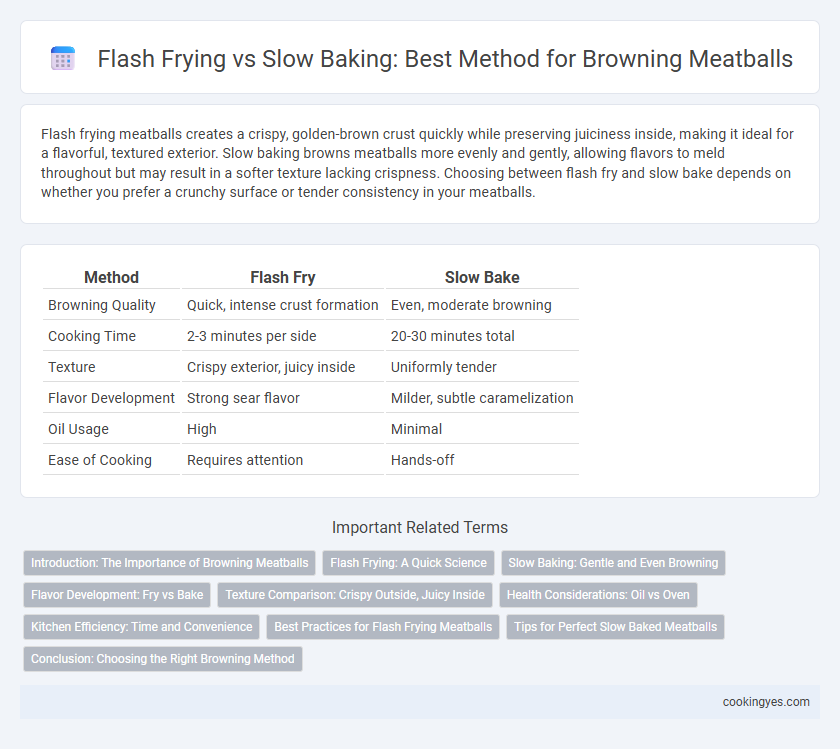Flash frying meatballs creates a crispy, golden-brown crust quickly while preserving juiciness inside, making it ideal for a flavorful, textured exterior. Slow baking browns meatballs more evenly and gently, allowing flavors to meld throughout but may result in a softer texture lacking crispness. Choosing between flash fry and slow bake depends on whether you prefer a crunchy surface or tender consistency in your meatballs.
Table of Comparison
| Method | Flash Fry | Slow Bake |
|---|---|---|
| Browning Quality | Quick, intense crust formation | Even, moderate browning |
| Cooking Time | 2-3 minutes per side | 20-30 minutes total |
| Texture | Crispy exterior, juicy inside | Uniformly tender |
| Flavor Development | Strong sear flavor | Milder, subtle caramelization |
| Oil Usage | High | Minimal |
| Ease of Cooking | Requires attention | Hands-off |
Introduction: The Importance of Browning Meatballs
Browning meatballs enhances flavor through the Maillard reaction, creating a rich, savory crust that elevates the overall taste. Flash frying quickly seals the exterior with a crispy texture, while slow baking allows even cooking with a gradual color development. Choosing the right method affects juiciness and browning depth, making it essential for delivering delicious meatballs.
Flash Frying: A Quick Science
Flash frying meatballs rapidly sears their surface, creating a Maillard reaction that intensifies browning and enhances flavor in seconds. This high-heat method locks in juices while forming a crispy crust, preventing moisture loss common in slower cooking processes. Flash frying's rapid temperature rise results in a superior texture and richly caramelized exterior compared to slow baking.
Slow Baking: Gentle and Even Browning
Slow baking meatballs ensures gentle and even browning, preserving moisture while developing rich, caramelized flavors through gradual heat exposure. This method allows heat to penetrate thoroughly, preventing the meatballs from drying out or burning on the surface. Slow baking enhances texture by creating a consistent, tender interior paired with a uniformly browned exterior, ideal for flavorful, succulent meatballs.
Flavor Development: Fry vs Bake
Flash frying meatballs creates a rich, caramelized crust through the Maillard reaction, intensifying savory umami flavors and delivering a crisp texture. Slow baking allows heat to penetrate evenly, producing tender interior meatballs with subtle browning and a milder, more uniform flavor profile. Choosing flash fry enhances depth and contrast in flavor, while slow bake emphasizes tenderness and juiciness without a pronounced crust.
Texture Comparison: Crispy Outside, Juicy Inside
Flash frying meatballs creates a crispy, golden-brown crust that seals in juices, resulting in a tender and juicy interior with a satisfying crunch. In contrast, slow baking provides more even cooking but yields a softer outer texture without the pronounced crispiness of frying. For optimal texture contrast, flash frying ensures a crispy outside while maintaining a juicy inside, enhancing the overall eating experience.
Health Considerations: Oil vs Oven
Flash frying meatballs requires oil, which increases calorie content and may introduce unhealthy fats, potentially impacting heart health. Slow baking meatballs in the oven avoids added oils, reducing fat intake and promoting a leaner, healthier dish. Choosing slow baking supports better control over nutritional quality while maintaining even browning and moisture retention.
Kitchen Efficiency: Time and Convenience
Flash frying meatballs creates a crispy, browned exterior within minutes, significantly reducing cooking time and enhancing kitchen efficiency for quick meal preparation. Slow baking develops even browning and thorough cooking but requires a longer duration, which may limit convenience during busy schedules. Choosing flash fry maximizes kitchen speed without sacrificing texture, making it ideal for fast-paced culinary settings.
Best Practices for Flash Frying Meatballs
Flash frying meatballs at high heat for a short duration creates a crispy, caramelized exterior while sealing in juices for tender, flavorful centers. Using a preheated pan with just enough oil to coat the surface prevents sogginess and promotes even browning. Patting meatballs dry before frying and avoiding overcrowding the pan ensures optimal Maillard reaction and uniform color development.
Tips for Perfect Slow Baked Meatballs
For perfectly browned slow baked meatballs, preheat the oven to 400degF (200degC) to ensure even cooking and a crispy exterior. Place meatballs on a lightly greased baking sheet or use a wire rack to allow air circulation, which enhances browning and prevents sogginess. Avoid overcrowding the pan, turning the meatballs halfway through baking to achieve uniform color and texture.
Conclusion: Choosing the Right Browning Method
Flash frying meatballs creates a crisp, evenly browned exterior by using high heat for a short duration, which seals in juices and enhances texture. Slow baking allows gradual, uniform browning that develops deeper flavors and a tender interior but may result in less crust. Selecting the ideal browning method depends on desired texture and cooking time, with flash frying preferred for quick, crispy results and slow baking suited for flavor-rich, tender meatballs.
Flash Fry vs Slow Bake for Meatball Browning Infographic

 cookingyes.com
cookingyes.com